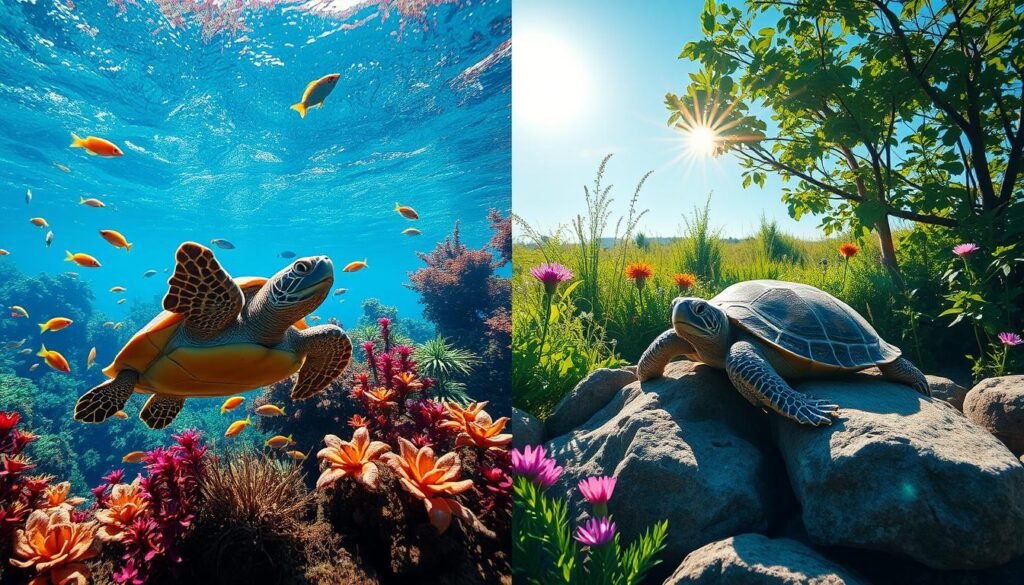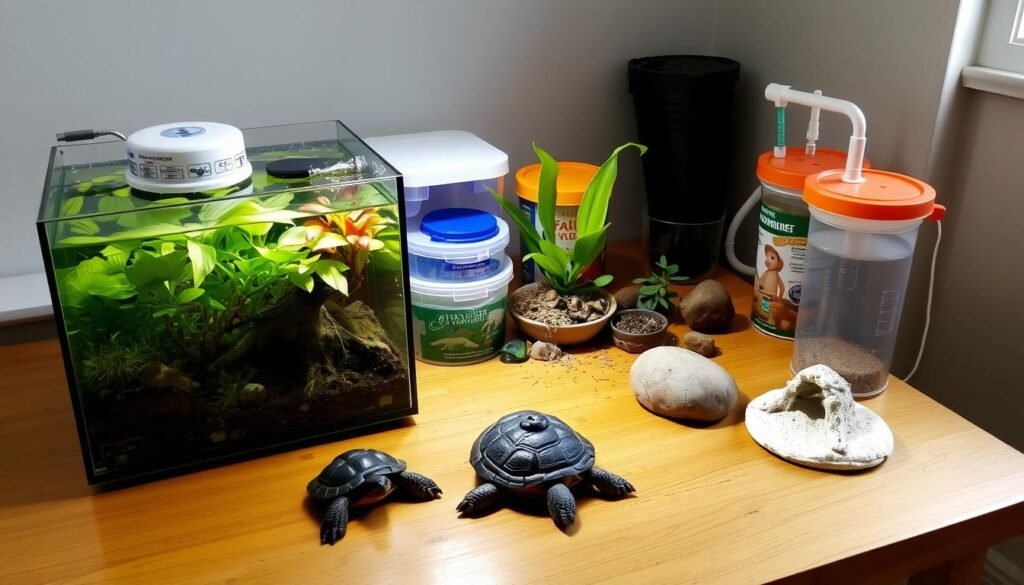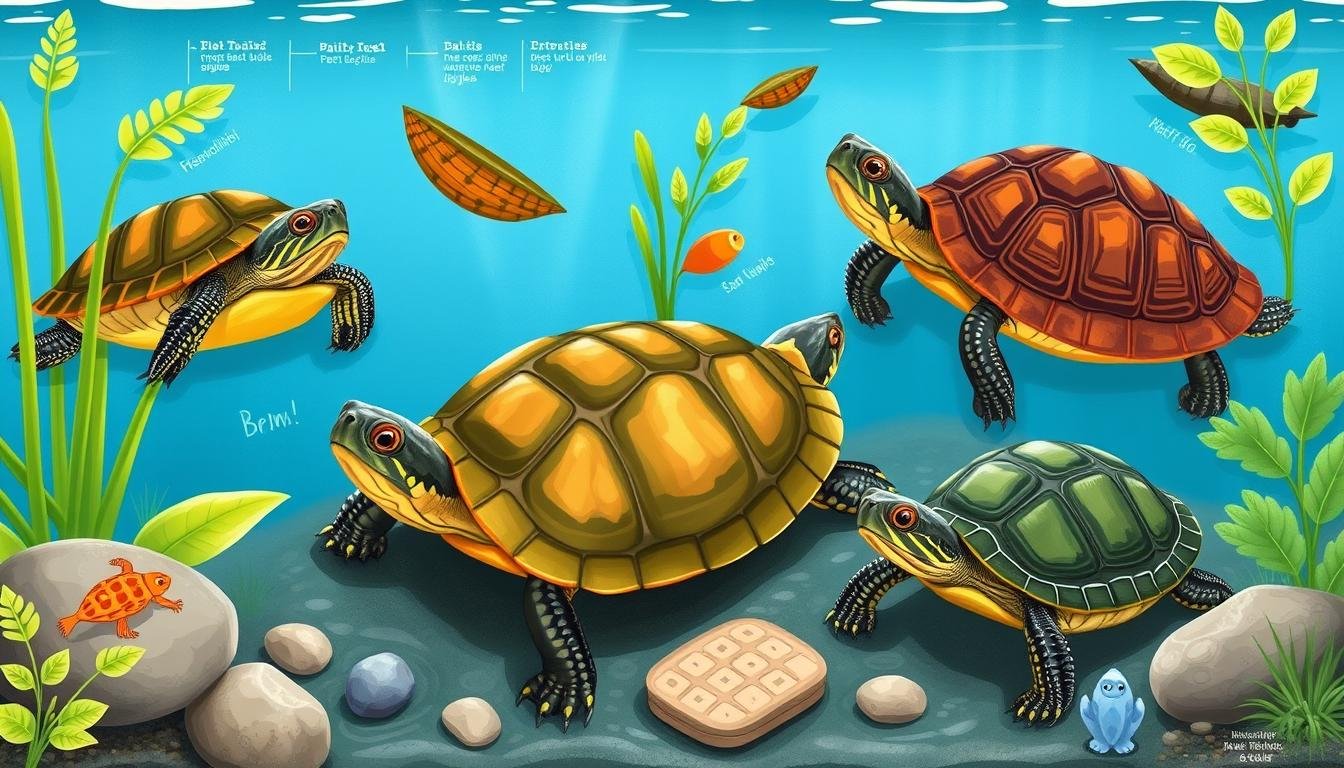Starting a journey with pet turtles is exciting for new owners. These reptiles offer a special bond that can last for decades. Knowing the basics is key for a great pet experience, whether you prefer aquatic or land turtles.
Turtles vary in size, from 3.5 to 12 inches, fitting different homes. The right turtle for beginners depends on several factors. Species like Red-eared Sliders, Box Turtles, and Painted Turtles are great for beginners.
Remember, turtles are a long-term commitment. They can live 20 to 60+ years with the right care. For beginners, turtles that grow to 4 to 8 inches are best, fitting most homes.
Choosing a turtle species requires research. Land and aquatic turtles have different needs. Some are social, while others are solitary. Knowing this helps pick the right turtle for you.
It’s also important to think about health. Turtles can carry Salmonella, so handling them safely is essential. Despite this, many find turtles to be rewarding pets that can form strong bonds.
Understanding Pet Turtle Basics
Choosing a pet turtle is a big decision. These reptiles can be great pets for those who know what they need. Not all turtles are good pets, so it’s important to do your research.
- Size and growth of different turtles
- What kind of home they need
- What they eat
- How long you’re willing to care for them
What Makes a Good Pet Turtle
A good pet turtle is strong, easy to care for, and fits well in your home. Turtles from the U.S. are often a good start for beginners. Male painted turtles, mud turtles, musk turtles, and red-eared sliders are great for new owners.
Common Turtle Species Overview
When looking at different turtles, think about their personality and how much space they need. For example, red-eared sliders are popular. They can live 15-25 years and grow up to 12 inches.
Lifespan and Growth Expectations
Turtles grow and live for different lengths of time. Most pet turtles can live 20 years or longer. They need a lot of care over time. Young turtles eat more protein, while older ones eat more plants.
Remember: Proper care and understanding are key to a healthy, thriving pet turtle!
Before getting a turtle, consider these important points:
- They need a big tank (at least 29 gallons)
- Regular vet visits are a must
- They have special diet needs
- There’s a risk of getting sick from Salmonella
Best Pet Turtle for Beginners: Popular Species Guide
Choosing the right pet turtle is an exciting journey for new reptile lovers. Different turtle species have unique traits that make them great for beginners. Let’s look at some of the most popular and beginner-friendly turtle options.
Red-eared sliders are a top choice for pet turtles. They are known for their bright red markings and lively nature. They do well in both indoor and outdoor settings, making them perfect for new turtle owners.
Top Beginner-Friendly Turtle Species
- Red-eared Slider: Highly adaptable and social
- Painted Turtles: Colorful and relatively easy to care for
- Musk Turtle: Compact size and low-maintenance
- Box Turtle: Terrestrial and unique personality
Musk turtles, like the razorback musk turtle, are great for those with small spaces. They grow up to six inches, making them perfect for small habitats. Despite their size, they have interesting personalities that many turtle lovers find charming.
“Choosing the right turtle is about understanding their unique needs and characteristics.” – Reptile Experts
Eastern box turtles offer a unique experience for pet owners. They live in eastern and central United States forests and need special habitats. They are great for those who want a turtle that’s more interactive.
Considerations for New Turtle Owners
- Research each species’ specific care requirements
- Consider available space and habitat setup
- Understand the turtle’s expected lifespan
- Evaluate your commitment to long-term care
Mud turtles are another beginner-friendly option. They are small and easy to care for, making them a great choice for new turtle owners. Each species has its own charm and care needs, ensuring there’s a perfect turtle for every owner.
Essential Housing Requirements for Pet Turtles
Creating the right habitat is key for your pet turtle’s health and happiness. Whether indoors or outdoors, knowing what your turtle needs is important. This ensures your turtle thrives in its new home.
Indoor vs Outdoor Enclosures
For beginners, indoor enclosures are the best choice. Glass aquariums are popular because they offer great visibility. When picking an enclosure, think about these important factors:
- Visibility and ease of maintenance
- Temperature control
- Protection from predators
- Consistent environmental conditions
Tank Size Requirements
Choosing the right tank size is vital for your turtle’s well-being. Here are some guidelines:
- Hatchlings: Minimum 20-gallon long tank
- Adult turtles: 55-125 gallon tank recommended
- Rule of thumb: 10 gallons per inch of turtle shell length
“A spacious habitat is key to a healthy, happy turtle.” – Reptile Care Experts
Setting Up the Perfect Habitat
A well-designed habitat needs careful attention to filtration, water quality, and environmental elements. Important components include:
- Filtration system: Process tank water at least four times per hour
- Basking area with proper UV lighting
- Water temperature maintained at 75°F
- pH levels between 6.0-8.0
Remember, different turtle species have unique habitat needs. Research your specific turtle type to create the best environment possible.
Aquatic vs Land Turtles: Making the Right Choice

Choosing between aquatic and land turtles can be tough for new pet owners. Each type needs a special habitat and care routine. This matches their natural home.
Aquatic turtles, like Red-eared Sliders, love water. They need a habitat with:
- Large swimming areas
- Basking spots with heat lamps
- Vertical tank configurations
- Filtered water systems
Land turtles, such as box turtles and tortoises, have different needs. Their home should include:
- Terrestrial spaces with substrate
- Small wading pools
- Dense vegetation for hiding
- Temperature-controlled environments
*The key is matching your lifestyle and available space with the right turtle species.*
When picking between aquatic and land turtles, think about tank size, upkeep, and your comfort with specific needs. Aquatic turtles need big tanks with complex water systems. Land turtles require detailed terrestrial setups.
Most turtle fans suggest starting with smaller, easier species like box turtles or Reeve’s turtles for beginners. These turtles are great for learning the basics of turtle care.
Temperature and Lighting Requirements
Creating the right environment is key for your pet turtle’s health and happiness. The right temperature and lighting are vital. They help keep your turtle healthy and happy, just like their natural home.
Basking Areas and UV Lighting
Turtles need special lighting to thrive. UV lighting is important for their health. It helps them make vitamin D and keep their bones strong. Here are some tips for UV lighting:
- Use UV-A and UV-B producing bulbs
- Replace UV-B fluorescent bulbs every 6 months
- Replace UV-B mercury vapor bulbs annually
- Provide 10-12 hours of light exposure daily
“Proper lighting is not just about illumination, but about supporting your turtle’s biological functions.”
Water Temperature Control
Keeping the water temperature right is very important. Different turtles need different temperatures. But most aquatic turtles do best in water between 68-80 degrees Fahrenheit.
- Use a submersible water heater for consistent temperature
- Aim for 78-80 degrees Fahrenheit for most species
- Create a temperature gradient in the tank
Maintaining Proper Environmental Conditions
A heat lamp is essential for a basking area. This area lets turtles dry off and control their body temperature. The basking area should be 10-15°F warmer than the water, around 85-95°F.
- Install a heat lamp with appropriate wattage
- Provide a dry basking platform
- Ensure the basking area allows full body drying
By managing UV lighting, temperature, and creating a great basking area, you’ll keep your turtle healthy. They’ll also have a comfortable place to live.
Feeding and Nutrition Guidelines
Knowing what to feed your turtle is key to their health. Most pet turtles are omnivores. They need a balanced diet that fits their needs.
“Proper nutrition is the foundation of a healthy turtle’s life”
How often you feed your turtle depends on their age and type. Young turtles eat more often, while adults eat less.
- Juvenile turtles: Feed 1-2 times daily
- Adult turtles: Feed every 2-3 days
- Omnivorous species require a mix of plant and animal proteins
Calcium is vital for turtle health. Vets say to add calcium powder to food 2-3 times a week. This helps avoid nutritional problems.
Recommended Turtle Diet Components
- Commercial turtle pellets (25-50% of diet)
- Fresh vegetables
- Live protein sources
- Occasional treats (maximum 5% of diet)
Be careful: Don’t give them processed foods, raw meats, or low-nutrition veggies like lettuce. Always check what’s best for your turtle’s type.
Health Care and Maintenance
Caring for a pet turtle needs dedication and detail. You must understand their health needs, keep their environment clean, and follow safety rules.
Regular Cleaning Routines
Keeping their habitat clean is key for your turtle’s health. Turtles make a lot of waste, so cleaning often is important. Here are some cleaning tips:
- Change water completely every 1-2 weeks
- Clean the filter every two to three weeks
- Remove uneaten food daily
- Use a soft brush to gently clean the turtle’s shell with lukewarm, dechlorinated water
Common Health Issues
Turtles face many health problems that need watching. Some common issues include:
- Shell infections
- Respiratory diseases
- Parasitic infections
- Vitamin deficiencies
“Prevention is always better than cure when it comes to turtle health.” – Reptile Veterinary Association
Handling and Safety Precautions
Handling turtles right is key to avoid stress and salmonella. Here are some safety tips:
- Wash hands thoroughly before and after handling
- Minimize handling to reduce turtle stress
- Use gentle, slow movements
- Never handle turtles immediately after feeding
Tip: Consult a veterinarian specializing in reptiles for annual check-ups and specific health advice for your turtle species.
Cost Considerations and Initial Setup
Getting a pet turtle means planning your budget carefully. The cost can change a lot, based on the turtle’s type and needs. You’ll need to set aside money for both the first setup and ongoing care to keep your turtle happy and healthy.

The first things you’ll need cost a lot. You might spend $200 to $2,000 for a good turtle home. Here are some big costs:
- Aquarium or terrarium: $100-$500
- Filtration system: $50-$300
- UVB and basking lights: $50-$150
- Substrate and decorations: $30-$100
- Initial turtle purchase: $20-$200
“Proper planning prevents poor turtle care and unexpected expenses.”
Long-term care also costs money. Red-Eared Sliders and Eastern Box Turtles can live up to 40 years. This means you’ll spend about $30 to $100 each month on food, water treatments, and vet visits.
If you’re watching your budget, pick a turtle species wisely. Some turtles need more complex homes, which can raise the setup costs. Always think about the long-term costs before you decide.
Conclusion
Choosing the right pet turtle is a big decision. You need to think about the species, their habitat needs, and the long-term commitment. Beginners should know that turtles can live a long time. For example, Red-Eared Sliders can live up to thirty years in captivity.
Being a responsible turtle owner means more than just basic care. Different turtles need different things, like special housing and diets. You must do your research and prepare to give your turtle the care it needs.
Having a turtle as a pet can be both hard and rewarding. By knowing what your turtle needs, you can create a great home for it. This way, you can build a strong bond with your reptilian friend.
Being a good turtle owner takes years of care and learning. With patience and dedication, your turtle can be a wonderful part of your family for many years.
FAQ
What are the best pet turtle species for beginners?
Beginners should consider Red-eared Sliders, Painted Turtles, Musk Turtles, and Box Turtles. These are easy to care for and adapt well. Red-eared Sliders are a favorite because they’re hardy and easy to find.
How large of an aquarium do I need for a pet turtle?
Start with a 20-gallon tank for hatchlings. As they grow, move to a 55-gallon tank for one or two adults. A 75-125 gallon tank is best for long-term care, providing enough space and a good basking area.
What do pet turtles eat?
Turtles eat a mix of commercial food, fresh veggies, and sometimes live prey. Adults eat 3-5 times a week, while young ones might need food daily. Don’t forget to add calcium supplements 2-3 times a week.
How long do pet turtles live?
Many turtles live over 25 years, with some reaching 80 years with proper care. This means they’re a big commitment for a long time, needing consistent care.
Do turtles need special lighting?
Yes, they need UV lighting or direct sunlight for 10-12 hours a day. A heat lamp is also key for a basking area 10-15°F warmer than the water. This helps with vitamin D and health.
Can I keep my turtle in an outdoor enclosure?
Outdoor enclosures are good but need careful planning. They must be safe from predators and fit the turtle and local climate. Indoor enclosures are better for beginners because they’re easier to control.
How often should I clean my turtle’s habitat?
Clean regularly. Change the water weekly and clean the whole habitat monthly. Use a good filter and remove waste fast. Always wash your hands after handling the turtle or cleaning to avoid salmonella.
What temperature do turtles need?
Turtles need temperatures between 60-90°F. Use a heat lamp for the basking area and a submersible heater for the water. Make sure there’s a temperature range for the turtle to regulate its body temperature.
How much does it cost to set up a turtle habitat?
Setting up can cost from a few hundred to ,000, depending on the tank and equipment. Remember, there are ongoing costs for food, supplements, and vet care. Turtles are a long-term investment.
Are turtles good pets for children?
Turtles can be interesting, but they’re not the best for kids. They need special care and can carry salmonella. Adults should supervise and help with turtle care.













